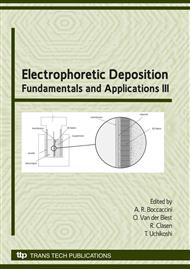p.165
p.171
p.177
p.183
p.189
p.195
p.201
p.209
p.215
Processing and Characterization of Biocompatible Titania Coatings by Electrophoretic Deposition
Abstract:
The electrophoretic deposition (EPD) technique was developed for depositing TiO2 films on stainless steel (SS) and titanium substrates. Titania coatings were obtained in conditions of optimal solution stability using acetylacetone suspensions of TiO2 nanoparticles and I2 at pH≈ 5. Deposition tests were carried out at 10V for varying times. The deposit thickness was seen to increase with EPD time, revealing that the deposits grew quickly for times <120 s, reaching a saturation value at longer times. The substrates were treated by physical and chemical methods before EPD in order to improve the adhesion of the films. The EPD coatings were sintered at 700, 800 and 900 °C under controlled argon atmosphere or in vacuum to study the influence of sintering atmosphere on crystalline phase transformation. The TiO2 coatings were characterized by XRD using Rietveld analysis. The results showed that TiO2 films on Ti substrates (chemically leached before deposition) had better adherence, homogeneity and density than those on SS. The coatings sintered al 700°C in vacuum resulted in a major proportion of anatasa phase. The porosity of the titania coatings sintered at 700°C (2 hr) in vacuum was calculated to be 19% .
Info:
Periodical:
Pages:
189-194
Citation:
Online since:
June 2009
Keywords:
Price:
Сopyright:
© 2009 Trans Tech Publications Ltd. All Rights Reserved
Share:
Citation:


